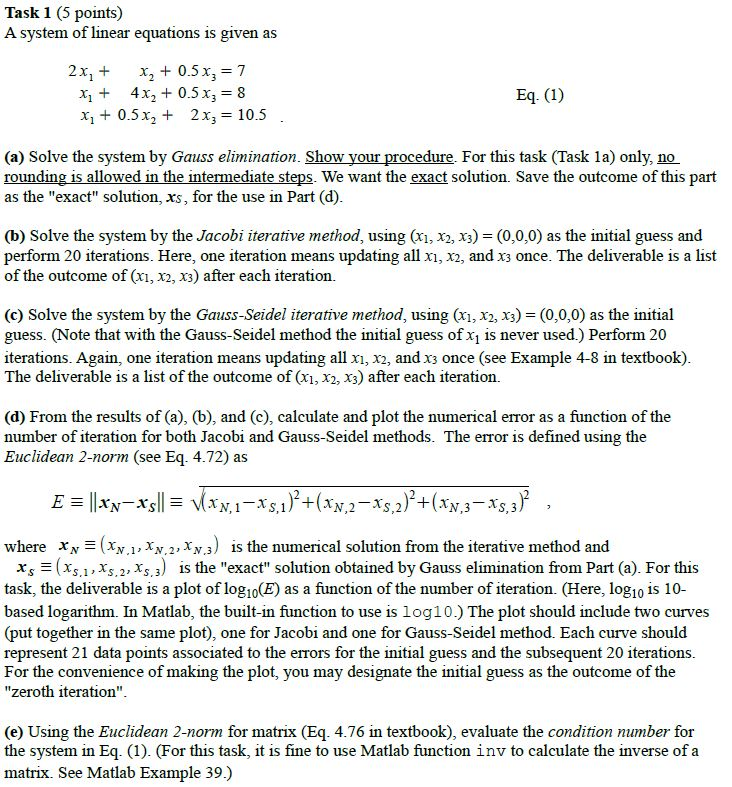Answered step by step
Verified Expert Solution
Question
1 Approved Answer
Task 1 (5 points) A system of linear equations is given as x0.5 x+ 2x3 10.5 (a) Solve the system by Gauss elimination. Show your

Task 1 (5 points) A system of linear equations is given as x0.5 x+ 2x3 10.5 (a) Solve the system by Gauss elimination. Show your procedure. For this task (Task 1a) only, no termediate steps. We want the exact solution. Save the outcome of this part undin we as the "exact" solution, xs, for the use in Part (d) (b) Solve the system by the Jacobi iterative method, using (xi, x2, x3) (0,0,0) as the initial guess and perform 20 iterations. Here, one iteration means updating all x, x2, and x3 once. The deliverable is a list of the outcome of (xi, x2, x3) after each iteration. (c) Solve the system by the Gauss-Seidel iterative method, using (xi,x2, x3) (0,0,0) as the initial guess. (Note that with the Gauss-Seidel method the initial guess of x1 is never used.) Perform 20 iterations. Again, one iteration means updating all x, x2, and x3 once (see Example 4-8 in textbook) The deliverable is a list of the outcome of (xi, x2, x3) after each iteration. (d) From the results of (a), (b), and (c), calculate and plot the numerical error as a function of the number of iteration for both Jacobi and Gauss-Seidel methods. The error is defined using the Euclidean 2-norm (see Eq. 4.72) as where xN(XN ,1, XN, 2, XN,3) 1S the numerical solution from the iterative method and xs (xs.1 , XS, 2, Xs,3) 1s the "exact" solution obtained by Gauss elimination from Part (a). For this task, the deliverable is a plot of log10(E) as a function of the number of iteration. (Here, logio is 10- based logarithm. In Matlab, the built-in function to use is log10.) The plot should include two curves (put together in the same plot), one for Jacobi and one for Gauss-Seidel method. Each curve should represent 21 data points associated to the errors for the initial guess and the subsequent 20 iterations. For the convenience of making the plot, you may designate the initial guess as the outcome of the "zeroth iteration" (e) Using the Euclidean 2-norm for matrix (Eq. 4.76 in textbook), evaluate the condition number for the system in Eq. (1). (For this task, it is fine to use Matlab function inv to calculate the inverse of a matrix. See Matlab Example 39.) Task 1 (5 points) A system of linear equations is given as x0.5 x+ 2x3 10.5 (a) Solve the system by Gauss elimination. Show your procedure. For this task (Task 1a) only, no termediate steps. We want the exact solution. Save the outcome of this part undin we as the "exact" solution, xs, for the use in Part (d) (b) Solve the system by the Jacobi iterative method, using (xi, x2, x3) (0,0,0) as the initial guess and perform 20 iterations. Here, one iteration means updating all x, x2, and x3 once. The deliverable is a list of the outcome of (xi, x2, x3) after each iteration. (c) Solve the system by the Gauss-Seidel iterative method, using (xi,x2, x3) (0,0,0) as the initial guess. (Note that with the Gauss-Seidel method the initial guess of x1 is never used.) Perform 20 iterations. Again, one iteration means updating all x, x2, and x3 once (see Example 4-8 in textbook) The deliverable is a list of the outcome of (xi, x2, x3) after each iteration. (d) From the results of (a), (b), and (c), calculate and plot the numerical error as a function of the number of iteration for both Jacobi and Gauss-Seidel methods. The error is defined using the Euclidean 2-norm (see Eq. 4.72) as where xN(XN ,1, XN, 2, XN,3) 1S the numerical solution from the iterative method and xs (xs.1 , XS, 2, Xs,3) 1s the "exact" solution obtained by Gauss elimination from Part (a). For this task, the deliverable is a plot of log10(E) as a function of the number of iteration. (Here, logio is 10- based logarithm. In Matlab, the built-in function to use is log10.) The plot should include two curves (put together in the same plot), one for Jacobi and one for Gauss-Seidel method. Each curve should represent 21 data points associated to the errors for the initial guess and the subsequent 20 iterations. For the convenience of making the plot, you may designate the initial guess as the outcome of the "zeroth iteration" (e) Using the Euclidean 2-norm for matrix (Eq. 4.76 in textbook), evaluate the condition number for the system in Eq. (1). (For this task, it is fine to use Matlab function inv to calculate the inverse of a matrix. See Matlab Example 39.)
Step by Step Solution
There are 3 Steps involved in it
Step: 1

Get Instant Access to Expert-Tailored Solutions
See step-by-step solutions with expert insights and AI powered tools for academic success
Step: 2

Step: 3

Ace Your Homework with AI
Get the answers you need in no time with our AI-driven, step-by-step assistance
Get Started


